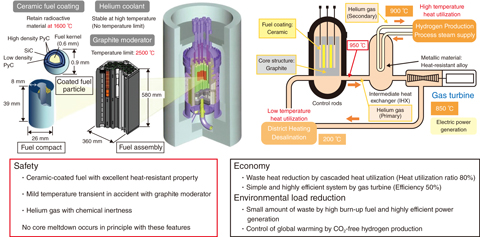
Fig.6-1 Features of HTGR
To remedy the fragility of our country’s energy supply-demand structure arising from excessive dependence on fossil fuel resources from abroad while simultaneously reducing greenhouse gas emissions in response to global warming, the basic philosophy of Japan is to advance nuclear-energy utilization on the premise of ensuring safety. We expect to use nuclear energy not only for power generation but also for various heat applications. The Strategic Energy Plan and the Japan Revitalization Strategy 2016, decided by the cabinet, list the promotion of research and development of a high-temperature gas-cooled reactor (HTGR) as a national policy because such reactors have excellent inherent safety and meet the energy demand for various industries. Reflecting on this social situation, the HTGR forum has been developing a strategy to commercialize HTGRs.
An HTGR can supply heat at a temperature of 950 °C using fuel particles coated with ceramics, graphite core material and inert helium, and can be designed as a meltdown-proof reactor in the case of any severe accident. The high-temperature engineering test reactor (HTTR) was constructed using the most advanced HTGR technologies developed in Japan such as coated-fuel-particle fabrication technology with excellent fission-product retaining performance and large-scale graphite-fabrication technology with high strength and irradiation resistance; it generated a temperature of 950 °C in 2004 for the first time in the world and demonstrated a stable supply of heat over a 50-day operation at 950 °C in 2010. We have demonstrated that even if the reactor cooling system shuts down and reactor scram fails, the reactor is naturally shutdown and kept in a stable condition.
HTGR has excellent safety features that allow it to respond to various industries, such as highly efficient power generation with a helium-gas turbine system, hydrogen production for fuel-cell vehicles and direct-reduction steel making, and seawater desalination using waste heat from a gas-turbine system (Fig.6-1).
We have promoted the establishment of safety standards for commercial HTGRs under international collaboration, taking advantage of the safety and economy features of HTGRs (Topic 6-1). We have also researched a fundamental advanced fuel technology to completely burn the Pu stored in Japan by HTGR (Topic 6-2) and developed oxidation-resistant graphite material to improve safety by preventing oxidation in any accidents (Topic 6-3).
As for the heat application research, the flowsheet around the Bunsen reaction, which is one of the key reactions of the Iodine-Sulfur process for producing hydrogen from water, was modified to improve hydrogen-production efficiency, and confirmation tests were conducted to confirm the applicability of the proposed technologies (Topic 6-4). Research and development of the demonstration test using the HTTR have been conducted to establish the hydrogen-electricity cogeneration system for enhancing the heat-utilization ratio (Topic 6-5). Moreover, the in-core graphite blocks in the HTTR, which stopped operation after the Great East Japan Earthquake (3.11 earthquake), were taken out from the core and visually inspected to confirm integrity in addition to the seismic evaluation (Topic 6-6).
We are preparing to resume operation of the HTTR by conducting the conformity review on new regulatory requirements issued by the NRA after the Great East Japan Earthquake.